| Author |
Message |
|
Tyler C.
|
 Posted: Tue 04 Feb, 2020 10:20 pm Post subject: Pattern Welded Rondel Dagger?? Posted: Tue 04 Feb, 2020 10:20 pm Post subject: Pattern Welded Rondel Dagger?? |
 |
|
Here is a beautiful little dagger said to be from Bavaria that I would love to hear some comments on. If I had to guess, I would place it as a rondel type dagger. I have seen a couple early rondels that have only wooden disks, or very thin iron plates over wooden disks that could easily rot away. There are a few in the RA like this. The location of the tang, the shape, size and style of the peen block all point to a rondel dagger. The thing about this blade that I am most intrigued by is the pattern welding. If it is in fact an early rondel, this would place it in late high medieval period. I was under the impression that pattern welding had gone out of fashion by this time. Has anyone run across a pattern welded rondel before, or a blade from this time period with a pattern welded blade? Could it be a re-shaped viking seax blade? Does the odd mix bring to question the authenticity? If itís not a rondel, what other type could it be? Would love to hear your thoughts.
 Attachment: 72.94 KB Attachment: 72.94 KB
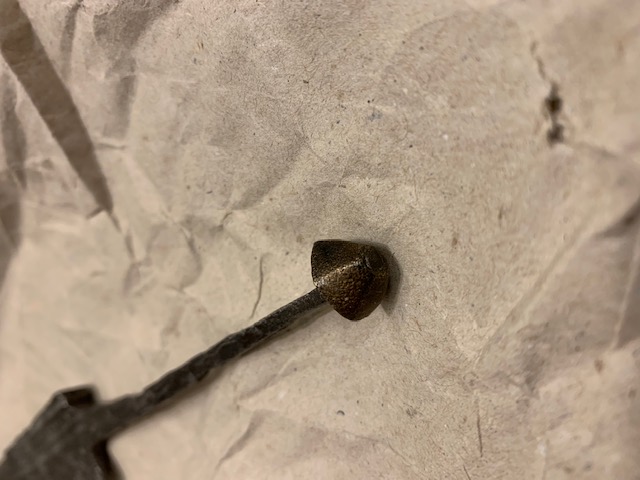
Peen block
 Attachment: 96.67 KB Attachment: 96.67 KB
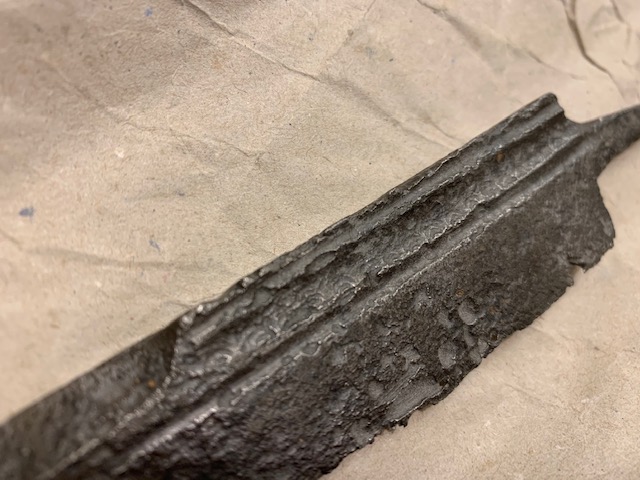
Pattern
 Attachment: 58.05 KB Attachment: 58.05 KB
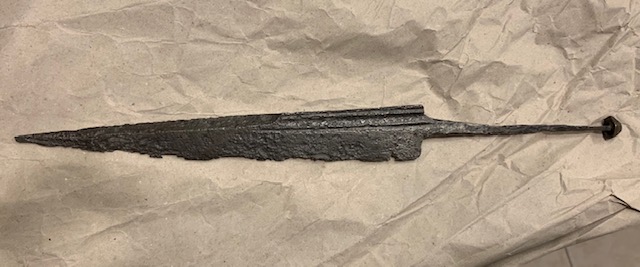
Full side
 Attachment: 107.04 KB Attachment: 107.04 KB
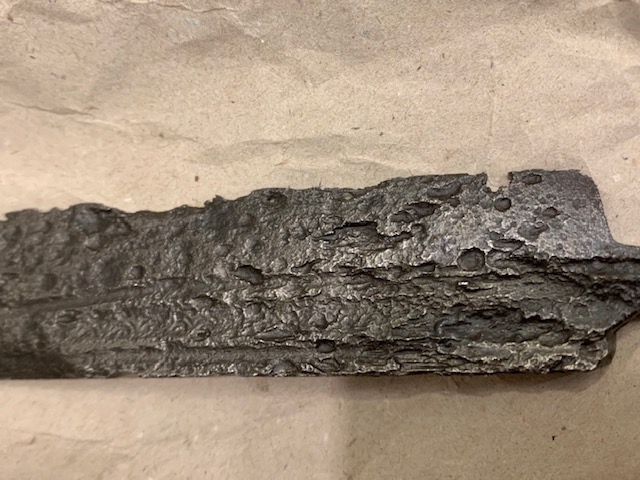
Opposite
 Attachment: 94.99 KB Attachment: 94.99 KB
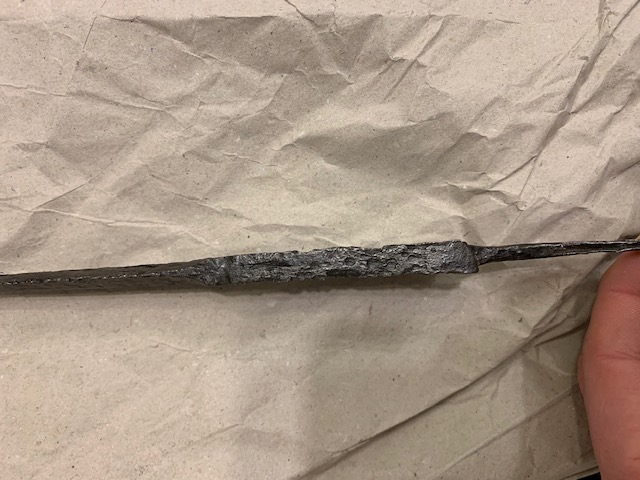
Spine
 Attachment: 90.24 KB Attachment: 90.24 KB
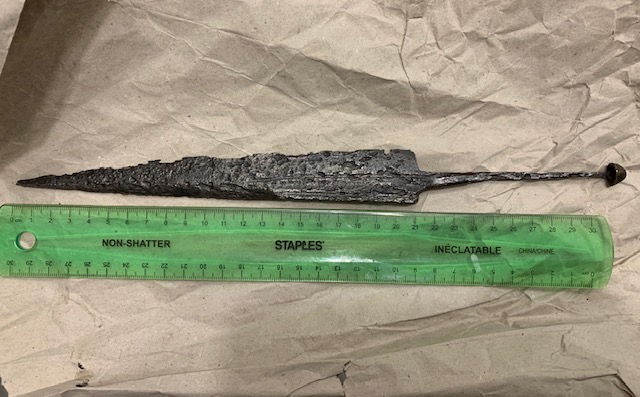
With ruler
|
|
  |
 |
Victor R.

|
 Posted: Wed 05 Feb, 2020 7:30 pm Post subject: Posted: Wed 05 Feb, 2020 7:30 pm Post subject: |
 |
|
Unless other metal parts corroded to the point of falling away and were not collected when the dagger was recovered, I'd suspect an all organic hilt, but my mind wouldn't go to rondel as the first choice. I'd more likely suspect something along the lines of a seax style grip.
There are a few styles of seax with inorganic components, and while those I've seen usually have at least a slender bolster and not just a butt cap/peen block, I did save a sketch of a Merovingian seax with just the peen block/butt cap. While your example may have been vastly different, I suspect it was closer to this than having all organic rondels. Then again, the problem with all organics is that we can't say what something looked like for certain unless it made a "good impression" before it decayed and we were able to see the void before it was disturbed or destroyed. Still, I think "rondels" is more akin to thinking "zebras" when you hear hoof beats (and you're not in Africa) while the seax style might be more akin to thinking "horses". Hopefully my analogy doesn't cause you to read this and think "jackass". 
The brief description I have of the example attached is as follows:
Weingarten, grave 283, Germany. Wooden grip, bronze pommel, OAL417mm, grip length135mm, blade length 282mm, width 32mm. Gilded bronze buttons (from sheath).
 Attachment: 20.86 KB Attachment: 20.86 KB

|
|
  |
 |
|
Tyler C.
|
 Posted: Thu 06 Feb, 2020 7:24 am Post subject: Posted: Thu 06 Feb, 2020 7:24 am Post subject: |
 |
|
Victor, thanks for the comments and analogy. I got a kick out of that  . .
The main reason that I shied away from thinking it was a seax is the blade shape. I have never seen a seax with straight sides that taper to an acute point like this does. This blade is also sharpened on both sides (after the fullers on the back side) which is also uncommon for a seax. The blade from your example is more like what I am used to calling a seax. Are you aware of any that have been found with a blade similar to the one in the pictures I posted?
I started thinking roundel after looking at the blades from the link below. Many have mostly organic handles.
https://collections.royalarmouries.org/hundred-years-war/arms-and-armour/type/rac-narrative-1147.html
|
|
  |
 |
Mikko Kuusirati

|
 Posted: Thu 06 Feb, 2020 10:02 am Post subject: Posted: Thu 06 Feb, 2020 10:02 am Post subject: |
 |
|
I would sooner think of a ballock rather than rondel hilt. They were often entirely organic apart from a small peen block, very much like this.
To me the tang also looks quite short for a rondel hilt with mostly organic rondels, as those were usually quite thick compared to most metal ones (although hollow metal rondels could also get very thick, for stylistic effect).
"And sin, young man, is when you treat people like things. Including yourself. That's what sin is."
ó Terry Pratchett, Carpe Jugulum
|
|
  |
 |
|
Tyler C.
|
 Posted: Thu 06 Feb, 2020 11:57 am Post subject: Posted: Thu 06 Feb, 2020 11:57 am Post subject: |
 |
|
A bollock dagger is a good thought. I had dismissed the idea because of the patter welded blade, but now that you mention it, why not?
Anyone have an example of a bollock with a pattern welded blade?
|
|
  |
 |
Victor R.

|
 Posted: Thu 06 Feb, 2020 5:06 pm Post subject: Posted: Thu 06 Feb, 2020 5:06 pm Post subject: |
 |
|
| Tyler C. wrote: | Victor, thanks for the comments and analogy. I got a kick out of that  . .
The main reason that I shied away from thinking it was a seax is the blade shape. I have never seen a seax with straight sides that taper to an acute point like this does. This blade is also sharpened on both sides (after the fullers on the back side) which is also uncommon for a seax. The blade from your example is more like what I am used to calling a seax. Are you aware of any that have been found with a blade similar to the one in the pictures I posted? |
I wholly agree: not much in common with a typical seax blade, simply what I got from the similarity of the remaining grip elements to the seax example I had, and the lingering of the term "seax" on my brain when you suggested use of a reclaimed Norse seax blade.
I agree that bollock is a very likely possibility, I'm just accustomed to seeing the more intricate bollock grip (the type with the inorganic bolster between the blade and the wooden bollocks) with such a fancy blade. The simple bollocks tend to have the more simple blade, but, again, tendency isn't "invariably".
|
|
  |
 |
Leo Todeschini
Industry Professional

|
|
   |
 |
|
Tyler C.
|
 Posted: Fri 07 Feb, 2020 8:52 pm Post subject: Posted: Fri 07 Feb, 2020 8:52 pm Post subject: |
 |
|
| Leo Todeschini wrote: | Nice blade.
I would shy away from rondel on the whole; it could be, but there is nothing particularly 'rondel' about it, so it could be many other types of dagger, but I would say medieval.
However I can't see the pattern welding. It would be odd for it to be medieval and pattern welded.........
Tod |
Thanks for your comments all! I love that this form exists where exceptionally knowledgeable people will share wisdom with beginners like myself and I get to nerd out over a rusty piece of iron.
The Juxtaposition of the medieval shape and the pattern welding is exactly why I thought this blade was so interesting, and why I posted it here. Personally I find the form very attractive and I love the addition of the pattern welding. I would like to recreate this blade at some point which is one reason Iím obsessing over the type. Itís also just fun to discuss it.
The pattern welding makes me think that it must be an early blade at the tail end of viking era. It also made me think that it must be a high status blade. These two ideas make me want to rule out a bollock dagger since at this time they were a lower status blade I believe. Going off of these wild assumptions what types remain that fit this blade style and age? Could it be from another period and I am thinking about it all wrong?
There are a few more pictures below that show the pattern welding better. You can see it in the main fuller. It looks like a twisted bar ground to about 1/2 way through. Judging by the pattern of the corrosion on the opposite side it looks like it is inlaid onto each side (I think I can see the corrosion pattern of the base metal underneath).
 Attachment: 131.91 KB Attachment: 131.91 KB
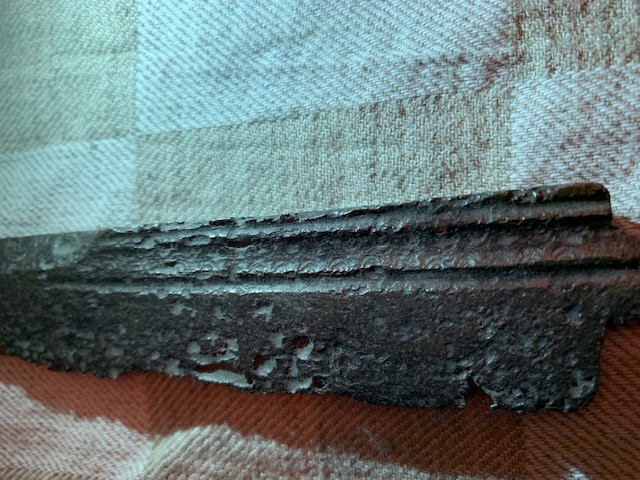
Pattern welding 1
 Attachment: 167.64 KB Attachment: 167.64 KB
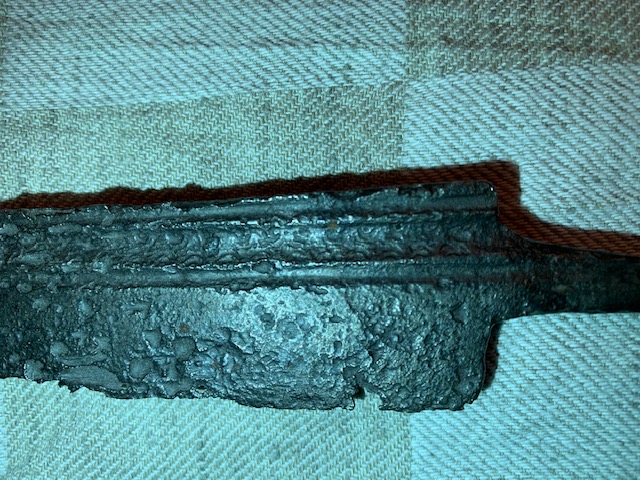
Pattern welding 2
|
|
  |
 |
|
Sean Manning
|
 Posted: Sat 08 Feb, 2020 12:45 am Post subject: Posted: Sat 08 Feb, 2020 12:45 am Post subject: |
 |
|
Tyler, I don't see it either. Most late medieval knives combine some hard metal on the edge and soft metal for the bulk of the weapon (and every piece of iron or steel was made by repeated heating and hammering and folding an ugly scary lump that came out of the smelter, so if usually has a 'grain' like wood).
I like the moderate size and the one-and-a-half edges, that shows up frequently in merchants' orders from cutlers but is not so often reproduced.
weekly writing ~ material culture
|
|
  |
 |
|
Tyler C.
|
 Posted: Sat 08 Feb, 2020 7:31 am Post subject: Posted: Sat 08 Feb, 2020 7:31 am Post subject: |
 |
|
Hi Sean,
If you look a little closer at the two pictures I shared in my last post you should see the pattern. Itís only in the main fuller and definitely not just a result of typical folding done during the initial working of the raw material. Let me know if you still canít make it out and Iíll try again to get some better pictures.
|
|
  |
 |
|
Sean Manning
|
 Posted: Sat 08 Feb, 2020 9:41 am Post subject: Posted: Sat 08 Feb, 2020 9:41 am Post subject: |
 |
|
Tyler, its rude to tell someone else what they should be seeing or hearing, especially with a very low resolution, poorly lit photo. I stand by my words: I don't see anything other than heavily corroded iron.
Edit: or do you mean the row of semi-circles on the flat between the two fullers? The knife looks like it was aggressively cleaned with chemicals so I would like to hear from people with experience with aggressively cleaned old iron.
weekly writing ~ material culture
Last edited by Sean Manning on Sat 08 Feb, 2020 2:22 pm; edited 1 time in total
|
|
  |
 |
Mikko Kuusirati

|
 Posted: Sat 08 Feb, 2020 11:52 am Post subject: Posted: Sat 08 Feb, 2020 11:52 am Post subject: |
 |
|
I do see something that may or may not be pattern-welding, a series of alternating loops or scallops along the fullers. It's a lot more obvious in a few photos than in others, and could also be the result of twisted or piled construction rather than pattern-welding, or even just a trick of light and the corrosion.
"And sin, young man, is when you treat people like things. Including yourself. That's what sin is."
ó Terry Pratchett, Carpe Jugulum
|
|
  |
 |
|
Tyler C.
|
 Posted: Sat 08 Feb, 2020 9:28 pm Post subject: Posted: Sat 08 Feb, 2020 9:28 pm Post subject: |
 |
|
| Sean Manning wrote: | Tyler, its rude to tell someone else what they should be seeing or hearing, especially with a very low resolution, poorly lit photo. I stand by my words: I don't see anything other than heavily corroded iron.
Edit: or do you mean the row of semi-circles on the flat between the two fullers? The knife looks like it was aggressively cleaned with chemicals so I would like to hear from people with experience with aggressively cleaned old iron. |
Sean, it was not my intention to be rude. I'll try to get some better pictures up for you. The blade has two small fullers with a larger fuller between them. The features that I am calling pattern welding are indeed the row of semicircles that can be seen in the larger fuller. It looks like the pattern that is achieved by grinding a twisted rod to %50.
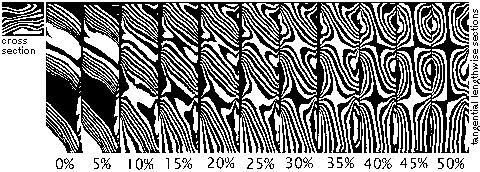
From: http://www.vikingsword.com/serpent.html
I'd also be interested to know what signs indicate aggressive cleaning. can you enlighten me?
Also, do you have any thoughts on type?
| Mikko Kuusirati wrote: | | I do see something that may or may not be pattern-welding, a series of alternating loops or scallops along the fullers. It's a lot more obvious in a few photos than in others, and could also be the result of twisted or piled construction rather than pattern-welding, or even just a trick of light and the corrosion. |
Mikko, if it is a result of a twisted or piled construction wouldn't there be pattern throughout the blade? On the rest of the blade I can see a straight fibrous texture characteristic of wrought iron, or steel derived from wrought iron showing in the corrosion pits, but only in the centre fuller area is there a repeating patter of semicircles. I have seen similar patterns before on viking period blades (example below). I'm a little surprised that this is not a nearly sure sign of pattern welding. I had imagined that this discussion would be about why there is pattern welding on a medieval style blade and not IF there is pattern welding haha  . I always like a good plot twist. . I always like a good plot twist.
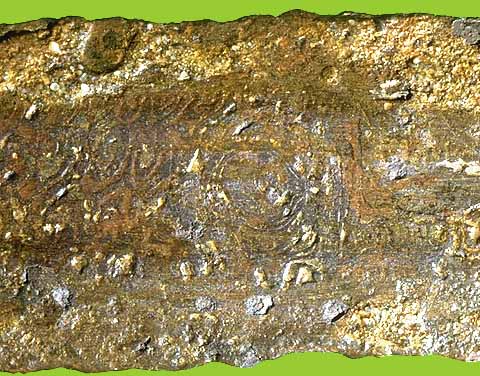
Also from: http://www.vikingsword.com/serpent.html
|
|
  |
 |
Mikko Kuusirati

|
 Posted: Sun 09 Feb, 2020 5:35 am Post subject: Posted: Sun 09 Feb, 2020 5:35 am Post subject: |
 |
|
AFAIK, welding steel edges to iron bodies was a thing even after pattern-welding as such went out of use, especially on knives and other shorter blades and tools, and sometimes the iron would be twisted or piled to strengthen it a little (twisted iron was even used in gun barrels at least as late as the American Civil War, due to shortages of suitable steel in the South).
I'm sure if we had the thing in hand there'd be a lot less disagreement, but contrary to popular misconception photographs effectively do their damndest to lie about everything and it takes a good deal of knowledge, effort and luck to make them reproduce reality faithfully and at least somewhat accurately.
"And sin, young man, is when you treat people like things. Including yourself. That's what sin is."
ó Terry Pratchett, Carpe Jugulum
|
|
  |
 |
|
Sean Manning
|
 Posted: Sun 09 Feb, 2020 5:43 am Post subject: Posted: Sun 09 Feb, 2020 5:43 am Post subject: |
 |
|
The thick black patina (with a lighter grey in the bottom of the pits) looks like it was aggressively cleaned, but I am a historian not an archaeometallurgist. Wade Allen has an assortment from Dordrecht and the Thames at London, the Museum of London can also show you want water finds look like. I don't know medieval ground finds as well.
The most useful thing to know would be what site this comes from, whether it was a water or a soil find, whether it comes from a strata or a scattered find, and who has owned it since it was found.
And yes, its ironic that as the first scholars in the 19th century were speculating about how pattern welded early medieval swords were forged, there were gunsmiths in the same city who were delivering pattern-welded gun barrels by the gross. Sometimes knowledge just does not travel between communities very well!
weekly writing ~ material culture
|
|
  |
 |
|
Tyler C.
|
 Posted: Wed 19 Feb, 2020 8:27 am Post subject: Posted: Wed 19 Feb, 2020 8:27 am Post subject: |
 |
|
Thanks again for the comments. Sorry it took me so long to respond to this. I simply have not had a spare moment recently.
For the sake of this discussion, if we suspend any disbelief that it is pattern welded, and assume that the location is correct, (Bavaria) where does that leave us? To me it seems that there are very few options. I would love to hear any thoughts or opinions on what type of knife this was, what period this blade is from, and why. Below is a sort of summary of the discussion points from others and my thoughts so far.
By my thinking there are only a few styles that may fit. It does not appear to be a seax because the blade shape is wrong for this type of knife (tapering to a point and sharpened on the reverse edge). It also does not appear to be any type of quillon dagger or antenna dagger because the guard/pommel parts on these types of daggers would have been hefty enough to stick around. This leaves some type dagger with a mostly organic hilt such as a bollock dagger or a rondel dagger. These two are the only two remaining options that I know of that fit this criteria. Am I missing a type?
The issue, of course, with the rondel dagger theory is that there are no rondels, and "nothing particularly 'rondel' about it". I have seen a number of examples with nearly all organic handles and thin steel plates which I imagine could easily and quickly corrode away. Here is an example:
https://collections.royalarmouries.org/object/rac-object-48904.html
Here is another one with only a copper alloy rondel remaining, which if it was steel may not have lasted. There are quite a few like this in the Royal Armouries collection.
https://collections.royalarmouries.org/object/rac-object-20094.html
It was also brought up that the handle length appears too short for rondel dagger, but after some investigation it seems to be very similar to many other examples (the tang on the rondel in the link above is actually exactly the same length 108mm).
A early bollock dagger hilt is a good option because they were often entirely organic. The issue with the bollock dagger theory is the pattern welding. Pattern welding was well out of style by the time that bollock daggers became a high status type but the presence of the pattern welding leads me to believe that it must be a high status blade. The style of the peen block on the end of the tang also does not fit well with any bollock daggers that I have seen.
I'm fascinated by this blade, and perhaps obsessing over it a little  . I want to determine the most likely handle form because I would like to recreate this dagger at some point and I want to get it right. I would love to hear any insights that may shed some light on it, or even just your vote for what you think it is: rondel, bollock, or something else. . I want to determine the most likely handle form because I would like to recreate this dagger at some point and I want to get it right. I would love to hear any insights that may shed some light on it, or even just your vote for what you think it is: rondel, bollock, or something else.
As always, thank you for your comments!
|
|
  |
 |
Mikko Kuusirati

|
 Posted: Wed 19 Feb, 2020 10:51 am Post subject: Posted: Wed 19 Feb, 2020 10:51 am Post subject: |
 |
|
Here are some examples of bollock and dudgeon daggers featuring wooden hilts with small peen blocks very much like this one:

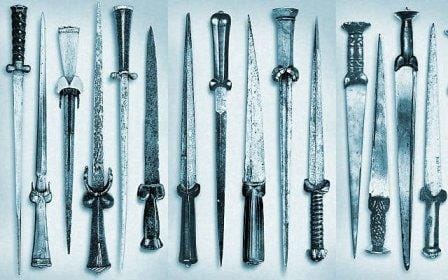
"And sin, young man, is when you treat people like things. Including yourself. That's what sin is."
ó Terry Pratchett, Carpe Jugulum
|
|
  |
 |
Mikko Kuusirati

|
 Posted: Wed 19 Feb, 2020 11:11 am Post subject: Posted: Wed 19 Feb, 2020 11:11 am Post subject: |
 |
|
Of course, one possibility would be rondels like this that have no metal parts attached to the tang:

"And sin, young man, is when you treat people like things. Including yourself. That's what sin is."
ó Terry Pratchett, Carpe Jugulum
|
|
  |
 |
|
Philip Dyer
|
 Posted: Wed 19 Feb, 2020 1:10 pm Post subject: Posted: Wed 19 Feb, 2020 1:10 pm Post subject: |
 |
|
| Mikko Kuusirati wrote: | Here are some examples of bollock and dudgeon daggers featuring wooden hilts with small peen blocks very much like this one:

 |
Cool, also the pattern welding on the ballock shape could indicate it was a repurposed seax blade. Rehilted and repurposed swords weren't uncommon so I wouldn't be surprised if someone reshaped a old seax blade for a different purpose.
|
|
  |
 |
|
Tyler C.
|
 Posted: Thu 20 Feb, 2020 7:03 am Post subject: Posted: Thu 20 Feb, 2020 7:03 am Post subject: |
 |
|
I love the idea that it could be a re-purposed seax blade, and I think it makes a lot of sense.
Earlier Sean asked what type of environment this was found in. It was found in the AltmŁhl forest in southern Germany in calcareous soil just in case this helps.
I have another little detail that may help to nail down the type. The tip of the blade is reinforced. You can see in the pictures that the false edge does not extend all the way to the tip. Instead the back widens again 2-3 cm from the end to reinforce the tip. It almost appears that the point forms a sharp chisel shaped edge perpendicular to the blade but it's hard to tell this for sure.
.
 Attachment: 97.11 KB Attachment: 97.11 KB
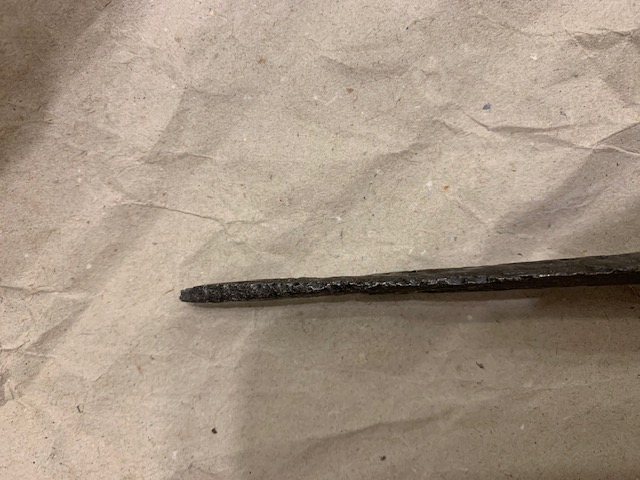
Tip shown from the back of the blade
 Attachment: 111.78 KB Attachment: 111.78 KB
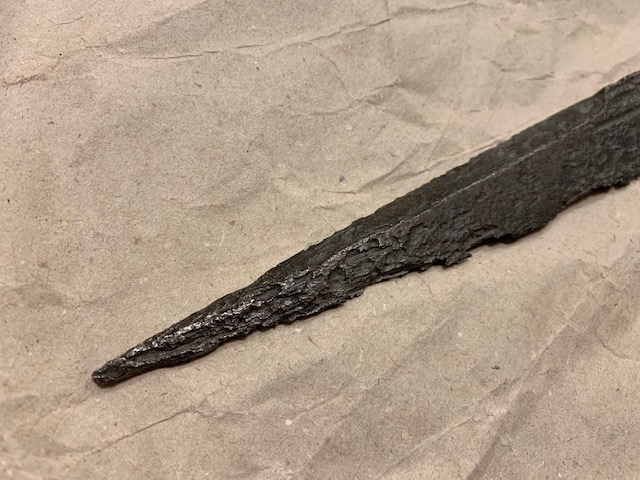
Tip shown from the side
|
|
  |
 |
|
|

